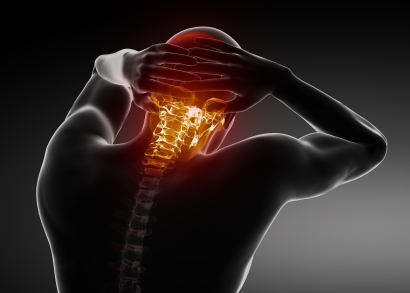
The Incredibly Common Upper Trapezius "Knot"
You know that feeling of a knot in your upper back sometimes just out of reach that you get when sitting at the computer or looking at your phone too long? It's the tender, tight, and painful spot in what most of us call our upper back or neck. This is the infamous upper trapezius trigger point.
We have long noticed this was a common complaint; now that more folks work from home in unfamiliar and often not optimal setups, we see this more and more. If you go to your husband, wife, daughter, son, or whomever and pinch their mid-upper trapezius, I can almost guarantee you they're going to say, "ahh, that's the spot." The number of patients we treat who have symptoms in this spot is incredible.
Why is the Trapezius is Causing Neck Pain?
Take a look at this photo that points out the trapezius muscle. The sheer size of your trapezius muscle is one of the reasons it causes neck pain. It's not just a neck muscle, or an upper back muscle, or a shoulder muscle. It's a muscle that's traversing and acting on all of these areas. The trapezius attaches to a long list of boney structures: your occiput (skull), cervical and thoracic spinal vertebrae (C7-T12), your scapula (shoulder blade), and your clavicle (collar bone). Besides boney structures, it also attaches the Nuchal ligament (a spinal ligament) and supraspinatus ligaments to the list. An issue with the trapezius muscle can have a wide range of effects near and far.
/GettyImages-147219941-56a05efe3df78cafdaa14c5f.jpg)
So, about that knot that I referred to earlier… It's called a myofascial trigger point in medical terminology, more simply referred to as a trigger point. A trigger point is a group of muscle fibres that are essentially "stuck" together in a contracted position. Despite being common, this is not a normal phenomenon or a good thing.
A Perfect Environment for Neck Pain
Is a trapezius trigger point causing your neck pain all by itself? It's not likely. Instead, it's probably the perfect combination of a few factors:
As mentioned earlier, the trapezius trigger point causes muscle and fascia knotting, abnormal muscle physiology, and the muscle's dysfunctional action.
Poor cervical (neck) neck positioning and posture that shift your head's load forward cause inefficient loading to the cervical spine and put additional strain on the muscles at the back of your neck, including your trapezius. This is so much more common now with the ubiquitous use of cell phones.

Many of us have weak middle back and shoulder muscles that struggle to maintain the balance between ou neck flexors (think chest and front neck muscles) and extensors (think shoulder and upper back muscles.)
Poor muscle activation and deconditioning that results in muscles becoming underactive and weak and tight.
The trapezius trigger point is often the key to address pain, but it's only one factor in very complex musculoskeletal and neurological systems. Estimates tell us that a quarter of people are suffering from neck pain at any given time and that neck pain tends to be episodic. If you have neck pain now or have had it before, you'll likely experience it again. However, the silver lining is that it's so common that there are plenty of strategies to address it.
How Can We Help Get Rid of Your Neck Pain?
Specialized treatments like Active Release Technique, Acupuncture, and Shockwave can also help alleviate pain and discomfort. These treatments work better when used, along with treatments like chiropractic adjustments.
Home strategies like massage, stretching, and foam rolling can help at least in the short term.
It is thought that one of the reasons trigger points may develop is the overuse of the trapezius. Specific exercises to strengthen and increase the upper trapezius capacity can be very helpful as a long-term remedy and help prevent it from coming back.
If you are struggling with neck pain, give us a call. We can help!





